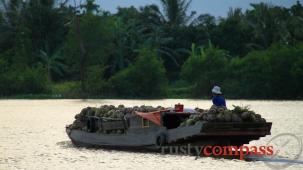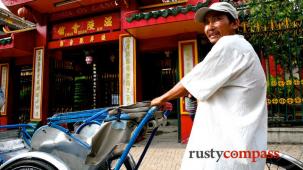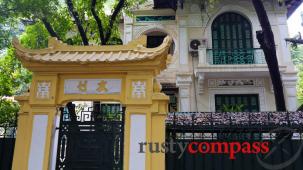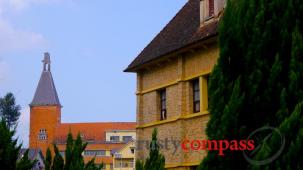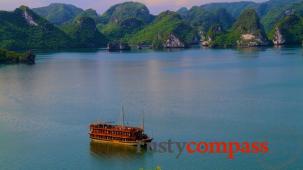Cai Be floating market and its distinctive cathedral.
The popped rice and candy factory is a pretty standard inclusion in a visit to Cai Be and is worth a look despite the touristy feel. This worker, now 35, lost his finger to this cutting process when he was 17.
The house of Ong Cai Cuong. Mr Cuong was a large delta landowner during the French colonial era. He was also well connected with the regime of Ngo Dinh Diem in the early 1960s. His impressive home set amidst lush orchards and fusing French and Asian styles dates from colonial times and is open to travellers. His grandaughter still lives there.
Ong Cai Cuong's photo is held by his grandaughter.
Elephant Ear fish is a mandatory culinary offering to visitors to the delta. Fortunately it tastes great in rice paper rolls with Viet greenery and fish sauce!
This gracious couple invited me in for a chat and some pomelo nearby my homestay.
The man was a practitioner of Vietnam's own calligraphy form known as chu nom. The French campaigned against the use of chu nom at the turn of the twentieth century. Drawing from Chinese characters, it was the country's indigenous script used by poets, Kings and mandarins for centuries. Its use is now confined to a small group of academics and students.
Delta canals are magical and make such a pleasant change from the stress of travel on Vietnam's roads.
"Determined to build cultured families" - these signs were on display outside all of the homes in the small hamlet in which I stayed.
Three generations of delta dwellers - grandmother and granchild with mum in the background - enjoying the cool of the afternoon.
The classic small town of Hoa Hinh is the delta that travellers seek out. Happily I was the only visitor.
Hoa Hinh market.
While the delta's main roads are dangerous, there are plenty of small paths around Hoa Ninh that are great for short rides.
My accommodation at Hoa Ninh was described as a homestay - but it wasn't. Instead, it was a very basic budget accommodation - no hot water, air conditioning or even doors on the rooms. It was pleasant enough and the staff were very nice, but there was no home or local family. I understand that this is the case with all homestays in the delta. Breakfast was simple and tasty and the setting was lovely.
Rambuttan orchard.
Ong Tam Ho, 82 is one of the most respected fruit growers in the delta. He and his family are still running the business.
The second factory stop was a brick kiln and pottery factory. It was another place where the role of women at the heavy lifting end of Vietnam's labour force was very apparent.
The recently deceased factory owner asked to buried in the middle of his factory. There was only one person working in the pottery section. She told us that exports to Europe had collapsed and the once booming business was in crisis.
Access to Can Tho still requires a ferry crossing and the wait is usually an hour and sometimes several hours.
Can Tho ferry. The opening of another bridge crossing over the Mekong to Can Tho in 2010 will mark the end of an era of river crossing by boat. The bottlenecks that the delta's booming economy have created at both sides of the ferry crossing mean that the bridge opening can't come fast enough for the locals.
The soon to open Mekong River bridge to Can Tho.
Some of Can Tho's last remaining shophouses
Uncle Ho watches over the Can Tho waterfront.
One of the most striking impressions from a visit to the delta is the extraordinary bounty of food that the river provides. Not only does it irrigate vast rice crops and fruit and vegetable gardens, its aquaculture output is also massive. Concerns about the river's viabilty in the face of global warming and overusage upstream by China, Laos, Burma, Thailand and Cambodia have not yet dampened the exuberance of the place.
I took a late afternoon boat ride on the river in Can Tho This late middle aged woman deftly navigated. Most of the boats are operated by women - some quite elderly.
Can Tho's riverfront market. Can Tho is a pleasant enough place but it seems to figure way too highly in Mekong Delta travel programmes. Its access to Cai Rang market is part of the reason and Cai Rang market definitely shouldn't be missed. Despite being the largest and most affluent city in the Mekong Delta, travellers will find plenty more charm cycling and travelling the canals of the delta's less developed locations.
Early morning commuters arrive at Can Tho port.
Cai Rang floating market - Vietnam's largest.
Cai Rang floating market.
Travellers at Cai Rang market.
On the way back to Saigon, we visited Ap Bac not far from My Tho. The battle of Ap Bac was a turning point in the Vietnam War. Way back in 1963 the Viet Cong won their first major victory against South Vietnamese forces who were deploying US choppers and armoured personnel carriers. The Viet Cong suffered 18 killed while the South Vietnamese ARVN suffered 80 dead. Three US advisors were also killed. These bizarre markers show where US choppers and APCs were destroyed.
Ap Bac has changed little since the early 1960s. It remains a sleepy hamlet where generations are buried in the rice paddies. There is something quite surreal about conjuring an important battle on the site. Ap Bac rattled the Kennedy administration and prompted much soul searching about a future US strategy for defeating the communists.
This man, in his nineties, was here when the battle was fought 46 years ago.


































